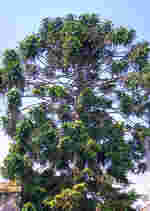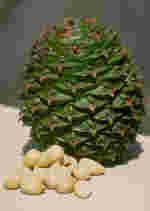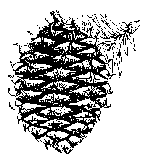
Tree (6).
Common Names
Bunya pine, bunya bunya pine (5).Taxonomic notes
Description
"A conical tree to 45 m. tall, 90-120 cm. in girth or more, becoming round-topped. Trunk free of branches for a considerable height. Branches long, pendent, branchlets clustered in whorls of 10-15. Bark gray-brown, thick, smooth, partially exfoliating in thin scales. Leaves spirally arranged, needle-like, non-imbricate, lanceolate, flattened, without a midrib, dark green, margins entire, apex with a long spine, to 5 cm. long by 0.5-1 cm. wide, with irregular stomata above, stomata below in regular lines Leaves on fertile branchlets incurved, non-keeled, 2.5 cm. long. Male cone in groups of 15-20, 1.2 cm. wide on high branches, on short branchlets; microsporophylls imbricate and denticulate. Female cone on branches high from the ground, erect, elliptic or globular, 4.5 kg. heavy, to 27 cm. long by 25 cm. wide or larger, scales with a long recurved spine. Seeds rounded, with rudimentary wings, 4-7 cm. long by 2.5 cm. wide, about 150 per cone. Cotyledons 2, germination hypogeal" (1).Range
Australia: inland subtropical forest of Queensland: type locale SE Queensland, Bunya Mountains, at about 800-1100 m elevation (1). A. bidwillii prefers the higher elevations of the range, giving way to A. cunninghamii on the lower slopes. Climate in the area is mild, with an annual rainfall of approximately l050 mm. Temperatures range between freezing and 30°C.Big Tree
In 1996, I measured one in the Bunya Mountains with a dbh of 172 cm.Oldest
No data, but ages >600 years seem inevitable.Dendrochronology
Ethnobotany
The hard-shelled nuts, about 5 cm long are edible and choice. They resemble giant piñon nuts. About every three years, between January and March, the bunya pine produces heavy cone crops. At such times, Aboriginals used to gather for tribal ceremonies, hunting, feasting, and corroborees. They came from as far south as the Clarence River in New South Wales, the Maranoa River to the west, and Wide Bay to the east. Particular trees were considered to be the property of certain Aboriginal families. They scarred the trunks of big pines to climb them, and these scars are still evident on many giant trees in the Bunya Mountains National Park. Cones were then knocked to the ground, where the soft young nuts were eaten raw and the mature nuts were roasted. After cracking the outer shells of mature nuts over the fire, kernels were pounded into meal and roasted into a kind of cake that would keep for several weeks. (3, 4).Bunya Pines have been planted in the southern [Australian] States, and the nuts may sometimes be bought in Sydney markets. They can be boiled or roasted" (3).
From the 1860s timber cutters established saw mills to harvest the timber wealth of the Bunyas. This led to the end of the great Aboriginal harvests in 1875, but began an era of intensive industrial logging that decimated the forests of the Bunya Mountains. In 1908, concern over the fate of the big trees led to creation of the 9303 hectare Bunya Mountains National Park, the second national park established in Queensland. The last sawmill on the mountain closed in 1945, and since that time, human use of bunya pine in its native range has focussed on its value as wildlife habitat and as a source of aesthetic pleasure (3, 4).
Bunya is still grown as a plantation tree for use as timber. Its cream-coloured wood is used for veneers, plywood, and boxes. It is grown outside Australia as an ornamental (5).
Observations
Easily seen in Bunya Mountains National Park, Queensland, and as an ornamental elsewhere in Queensland and New South Wales. Occasionally planted as an ornamental in the United States, e.g. a specimen 36 m tall in the Capitol Arboretum, Sacramento, California.Remarks
For pollination mechanisms, see Araucaria .Citations
(1) Silba 1986 .(2) van Gelderen et al. 1986 .
(3) ANBG Aboriginal Trail page .
(4) Queensland National Parks and Wildlife Service. 1994. Park guide: Bunya Mountains National Park.
(5) "bunya pine," Britannica Online .
(6) Hortus Botanicus Catinensis .
See also:
Hall et al. 1970
.
Vascular Plant Image Gallery
.
[ Araucaria ] [ Araucariaceae ] [ home ]
This page is from the Gymnosperm Database
URL: http://www.geocities.com/RainForest/Canopy/2285/ar/ar/bidwillii.htm
Edited by Christopher J. Earle
E-mail:
earlecj@earthlink.net
Last modified on 21-Dec-98

